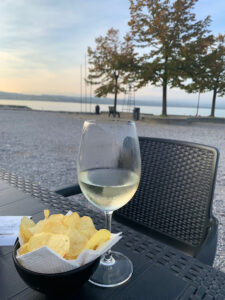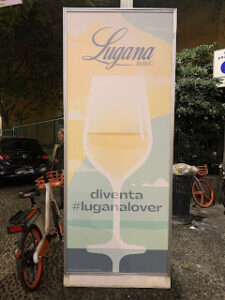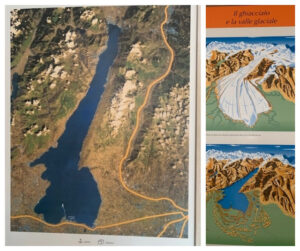
“Wine is sunlight, held together by water.”
— Galileo
Several years ago, I attended an Amarone tasting in Los Angeles, where there were just few white wines being poured. What was this grape, I asked, and was told it’s ‘Turbiana.’ I’d never heard of it. It’s not Trebbiano, the ubiquitous white wine grape of Italy, it’s Turbiana, which is the grape grown in the Lugana region of Northern Italy. (Turbiana is a distant relative of Trebbiano, of which there are 30 total.) Turbiana makes white wines, from young and crisp versions to lovely sweet versions, and it also makes a sparkling wine. I was impressed by these white wines at the Amarone tasting, and I truly loved what I was tasting. I dubbed these Lugana whites the ‘Chablis of Italy.’ Subsequently, at my sales job at The Wine House, I became the biggest pusher of Lugana whites, and would like to think I raised their reputation with our clientele (as well as sales). One year at the “Great Whites Fest” that I’ve hosted a Lugana white was the best-selling wine.
I guess you could say I’m a true believer in the lovely white wines of Lugana!
‘Refined Lakeshore White Wine’
The Wine Media Conference 2022 was held in Lake Garda, Italy, in late September, and the main sponsor was Ascovilo, which is the Association of Consorzi Tutela Vini Lombardi, encompassing all the DOCG, DOC and IGT areas of Lombardy, Italy. Consorzio Tutela Lugana DOC is a member of this association, along with the following: Oltrepo Pavese, Vini Mantovani, Valtenesi, Garda DOC, Valcamonica, Moscato di Scanzo, San Colombano, Terre Lariane, and Valtellina. (Noticeably absent from the group is Franciacorta, which is still being wooed to join the group.)
While at WMC, I elected to attend the pre-conference excursion to the Lugana area, as I wanted to see where these wines I had discovered years before were from and what Lugana was all about.
Facts on Lugana
The Lugana DOC sits on a Morainic plane south of Lake Garda, Italy, and extends across two provinces, Brecia and Verona, as well as two regions, Lombardy and Veneto, and encompasses five villages: Peschiera del Garda in the Veneto region, and Desenzano, Sirmione, Pozzolengo and Lonato in Lombardy. The area’s viticultural history dates back to Roman times, but the appellation dates just to 1967. It’s a fairly small one, about 2500 hectares (about 6200 acres) total.
The area has temperate climate due to the “lake effect,” and most vineyards are oriented north-south. The glacier pushed down the soil as it moved and melted, and it’s clayey, with rock, red soil, and iron below. The amount of clay varies from 20-40%, depending on closeness to the lake waters.
 |
| Beautiful poster on display in Milan. |
The DOC produces 27.5 million bottles per year, 90% of which is still wine, 10% is sparkling. Per Fabio Zenato, the newly elected president of the Lugana Consortium, and a host and speaker at WMC, about 70% of Lugana’s wines are sold outside of Italy, with Germany the main market. Note that Lake Garda gets close to 7 million tourist per year, many of them German. Only 5% of Lugana wines make it into the US market. That’s something Zenato and the consortium are trying to change. I was really impressed with the marketing materials the Lugana folks have put together, featuring the hashtag #luganalover. Light and lively (like the wines) posters were prominently displayed all around the town of Desenzano, where the conference was held, and even in Milan (see an example, right).
About 90% of all production in Lugana is using the Turbiana grape, and to be labeled as Lugana DOC, the wine must be a minimum of 90% Turbiana. The other 10% can be any other non-aromatic white, including both local and international varieties.
There are approximately 200 producers in the Lugana, some of them large scale, many of them small scale family owned wineries. Lugana is a “quiet, very strong machine of quality,” says Zenato.
Categories of Lugana DOC Wines
Lugana DOC wines are the everyday drinkers, fresh, aged in stainless steel, made to be drunk in their vintage year. They are straw-colored with greenish highlights, and have delicate aromas of flowers and almonds, and on the palate they are light, lively, fairly full-flavored, and quite elegant. They are, to me, the perfect wine to drink while on a beach chair gazing out on Lake Garda (see photo above).
Lugana Superiore wines must age for a least one year from the time the grapes are harvested. They are richer and more complex as a result, with wild herbs, ripe apples, tangerine, hazelnut and spices. These wines can be cask aged, and the choice for most producers is large capacity casks. Like the DOC wines, they have great acidity, with minerality and savory notes. Note that each winery “has it’s own interpretation” of oak aging, per the consortium’s Zenato.
Lugana Riserva must age for 2 years, with 6 months of that in the bottle. The color on Riservas is deeper, and the wine is even more complex and elegant, with smoky and flinty notes, balsamic, and even more minerals on the palate.
Lugana Vendemmia Tardiva are Lugana’s late harvest wines, which are high acid and not unctiously sweet, like many ‘dessert’ wines can be. The grapes are ‘over-ripe,’ left on the vine till late October or even later, and the wines are rich, soft, and dense, just delicious! Think Alsace VD or German Spatlese.
Lugana Spumante was a surprise to me. These sparkling wines are made using the Charmat Method. They are simple, crisp, citrusy and just fun to drink.
So, what really makes a Lugana white so special? According to Zenato, it’s the way the Turbiana grapes responds to the unique soils that were deposited hundreds of thousands of years ago by the giant glacier that formed the lake. The soils impart a minerality to the grapes, a ‘sipidity’ that, combined with the natural acidity of the grape, and its fruitiness, creates a special and unique expression of a white wine. I like to think of it as refined lakeshore white wine! Most producers now make their wines with 100% Turbiana as its a more realistic and authentic expression of a Lugana white, says Zenato.
The average price on the export market for a bottle of Lugana white ranges from $22 to $26. Check out the wines currently in stock at The Wine House.
One more thing: I watched an episode of Italian Wine Podcast where Zenato was interviewed by host Stevie Kim (and a speaker at this year’s WMC), and I highly recommend it if you want to hear the facts directly from the President of the Lugana Consortium. He’s a charming man, well spoken, and a staunch proponent for Lugana. I was especially pleased to hear him say that the wine that comes closest to Lugana in style and character is Chablis!
In my next post or two, I will profile some of Lugana’s producers.
Until then,
Ciao and Cin Cin!

